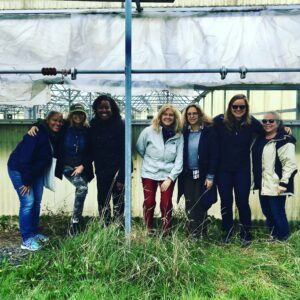In the northwest of Washington state, the northwest corner of the Pacific Northwest, sits berry country. In this area between the Cascade Mountains and the Pacific Ocean the climate is mild and relatively cool, which berries like. Washington produces the most blueberries and raspberries in the US, with some 60 percent of the country’s red raspberries coming from Whatcom County alone. In a state known for its diversity of agriculture, berry yields actually fall short of Washington apples and cherries. However, berries are ground zero for Washington’s farmworker-justice movement.
The movement is led by Bellingham-based Community to Community Development (C2C), a women-led, grassroots organization dedicated to immigrant rights and food sovereignty, which is defined as a peoples’ right to food and farming that is healthy, culturally appropriate, and produced by ecologically sound methods (Both C2C and WhyHunger are members of the US Food Sovereignty Alliance.)
Originally formed in 1980 by a group of Bellingham activists, C2C’s founding mandate supported farmers in El Salvador during the Civil War. The group was mostly women who raised money to support rural peasant villages. The goal was self-determination for Salvadorean farmers to feed themselves and protect land they had worked for generations. As the crisis in El Salvador eased during the 1990’s, C2C went dormant.
In 2004 Texas-born organizer Rosalinda Guillen resurrected C2C with a new mission—fighting for domestic farmworkers’ rights. Guillen is a tiny woman with a huge presence. At barely five-feet-tall, her voice carries authority. When she speaks, everyone in the room is reverent.
Guillen comes from a farmworker family and grew up in migrant labor camps. Working in collective bargaining with the Rainbow Coalition and later the United Farmworkers of America (UFW), Guillen contributed to historic organized-labor wins for farmworkers in Washington and California. In 2001 Guillen represented the UFW at the World Social Forum in Brazil. There she was deeply inspired by the Marxist land-reform ideals of the Landless Workers’ Movement and the collective-leadership organizing principle called Peoples Movement Assembly (PMA). Guillen left the forum fired up to create a new way of organizing.
Since C2C’s original mission aligned with Guillen’s, she sat down with the founding board members to map out the organization’s future. “We said, this is what farm workers need in the US,” she explains. “C2C was doing this for Salvadorean peasants, but US farmworkers are landless peasants.”
Guillen also was passionate about maintaining C2C as eco-feminist and women-led. “How do you develop social change models intentionally from a women’s perspective?” she asks. “What is that? We never had the opportunity to do that because everything is controlled by the patriarchy.”
Eco-feminism respects both the earth and the health of farmworkers. Organic farming, for example, is not just about eating organic berries. It’s about the health of the people who produce the berries. And critically, the organization’s agenda is determined by the community it serves, not the other way around. This is key to the Peoples Movement Assembly methodology. As their mission states: “The PMA puts the trust and leadership in the people assembled to make decisions together. It is not about a single leader, organization, or pre-determined goal.” C2C does not equal Rosalinda Guillen.
“This is the first place where I’ve seen a farmworker justice movement like this,” says Maureen Darras, co-developer of farmworker-owned cooperatives, who joined C2C in 2017.
Everything about C2C is fluid. There could be ten people working there or 700 volunteers—depending on C2C’s current agenda. C2C might be building a farmworker-owned business or it could suddenly pivot to respond to a strike or a US Immigration and Customs Enforcement (ICE) raid on undocumented workers. The priority is always shifting.
“We’re always adjusting with each other so whatever is emerging in social movements is supported,” Darras says. “We either pull back or double up depending on what’s going on. We want to be able to respond whenever the community is ready to self-organize with the support of the organization, all the resources, and our collective skills.”

Crisis at Sarbanand Farms
At C2C’s office in Bellingham, Mexican farmworker Honesto Silva Ibarra’s photo has its own altar. In August, 2017, Ibarra, a 28-year-old married father of three, died while working blueberry fields at Sarbanand Farms. At the time a heatwave in Whatcom County combined with smoke from wildfires across the Canadian border created hazardous air quality—conditions for the general public to avoid exertion outdoors. But it was the height of picking season. Farmworkers perform physical labor, during long hours, regardless.
The farmworkers at Sarbanand knew the drill: “Al menos que se estén muriendo, no falten.” (Unless you are dying, don’t miss work.) Ibarra complained to his bosses of headaches and exhaustion. When he tried to rest, he was told to go back to work or risk getting fired and deported. Silva collapsed and later died at a hospital in Seattle. (Doctors determined Ibarra died of natural causes. However, the Washington State Department of Labor and Industries later fined Sarbanand for meal- and rest-break labor-law violations.)
Ibarra had been hired via the government’s H-2A guest worker program, which allows US employers to bring temporary foreign workers into the States for agricultural work. Under the H-2A program, employers are required to provide housing for the foreign workers.
Workers report crowded and unsanitary quarters—and bedbugs. Often security guards are on watch; windows are barred. And the farmworkers describe details of wage theft and insufficient or poor food and water provisions.
“Workers are tied to their employers,” says Edgar Franks, political director for the union that C2C helped form, Familias Unidas por la Justicia, Families United for Justice (FUJ). “If you’re an H-2A worker, your visa is dependent on the job. You’re bound to stay there and finish your contract. The disciplining is arbitrary. If you’re not producing enough, mouthing off, give a dirty look, sleep in, or you’re sick, the employer can fire you, and you have to go back to your home country. . . It’s a lot of exploitation.”
Proponents of the H-2A program say it solves labor shortages for employers and allows foreign workers to earn much more than they would in their native countries. C2C, along with Farmworker Justice and the Southern Poverty Law Center, among others, oppose it—to say the least.
“It’s a quasi-slave-labor program that is legal and has been agreed to by the US and Mexican governments,” says Guillen.
After Ibarra’s death, his fellow H-2A workers went on strike to protest Sarbanand’s working conditions and management’s negligence of Ibarra’s medical needs. Sarbanand owners fired the workers and asked them to leave immediately. However, rather than self-deport, the workers left the grounds and contacted Ramon Torres, president of FUJ.
Franks described the scene in Sumas, the town two miles away, as farmworkers wandered the streets with suitcases and backpacks. “It was hectic,” he says. “There was a lot of confusion, anger, and frustration.”
C2C helped the workers with temporary housing while they figured out what happened. Community members brought tents, food, clothes, blankets. Union leaders informed the workers about their rights, got lawyers, contacted the Department of Labor and Industries and the Department of Health. C2C and the union listened to what the workers wanted: back pay, justice for Ibarra’s family, and for some of them, even the ability to return to work under the H-2A program in the future.
Ultimately, H-2A workers are not legalized to find other work in the US, should their initial employment contract end. The Sarbanand workers returned to Mexico.
Oversight for H-2A Program
Nationwide, reliance on H-2A temporary workers at farms across the US tripled between 2008 and 2018. In Washington alone, the number of H-2A workers coming to the state grew by more than one thousand percent since 2007.
In August, 2019, Washington passed a law providing resources for oversight of the H-2A program. According to the state legislature’s bill, the federal government has not provided the funding to “adequately ensure the protection of workers and growers.” Where Washington, D.C. has not stepped up, Washington state will.
C2C deserves credit for pushing forward the state’s progressive win for farmworkers. Guillen organized protests in Olympia “banging on the governor’s door,” she says. “We fought for three years, reporting the lack of oversight from state agencies. . . Honesto’s death was an example of everything we have been talking about.”
And C2C remains active in the battle with a seat on the advisory committee alongside representatives from big ag. “There’s a new-found respect for us,” Guillen says. “I feel hopeful that we can do something. The federal government is looking to make changes to H-2A, which could [undermine] our efforts.”
In fact, C2C opposed the Farm Workforce Modernization Act (FWMA), which was passed by the US House of Representatives in December, 2019. Despite bi-partisan support for the bill, C2C called out dangers it could set in motion for the majority of farmworkers. Notably, the FWMA expands the H-2A program. And though it offers a path to legal immigration status for undocumented, domestic farmworkers, in a written statement C2C stated that the “highly detailed and convoluted 223-page piece of legislation outlines a complicated, costly process to legalization that only applies to a fraction of undocumented farmworkers who currently live and work here.”
“We’re in a dangerous period now,” Guillen says.
Bolstering the Union, Building Coops
US agriculture’s reliance on H-2A workers will not dissipate any time soon. Because of this, the creation of the FUJ union cannot be under-stated. Ibarra’s death at Sarbanand Farms was a tragic manifestation of systemic issues for farmworkers: abusive treatment, rampant labor and housing violations, wage theft, even just using a bathroom. The union was the key for the workers in crisis.
“Because the union existed and the leadership is involved in the farmworker community, they were called,” says Guillen. “If there hadn’t been a union, the workers wouldn’t have been able to reach out to get help. All the exploitation is more easily exposed. For us that’s the urgency for C2C to do more work. . . so the union will grow and be more powerful.”
Ibarra’s death followed four years of strikes and boycotts at one of the largest berry farms in the state, Sakuma Brothers. It was the dispute at Sakuma Brothers that led to the creation of the union. There is now a negotiated contract in place for as many as 800 farmworkers at Sakuma Brothers with a guaranteed $15 hourly rate and job protections in place. It’s “a huge win” that Guillen wants to see branch out to other sectors of Washington’s ag economy: vegetables, wine, seafood, dairy.

Still, the union contract is only part of C2C’s ongoing fight for farmworker justice. Since 2006, C2C has developed six coops for farmworker-owned businesses. This is the ultimate goal for food sovereignty: creating the coops to give farmworkers the ability to choose and produce culturally appropriate food in a healthy, ecologically sound, sustainable way.
It’s a work in progress. The initial five coops all dissolved—though not without lessons learned along the way. For the first coop, a group of women caterers called Las Margaritas, C2C was able to provide business planning, marketing, funding, volunteers; even getting them a van. But they couldn’t raise enough money to get the women their own commercial kitchen.
For Cooperativa Jacal, a farming coop on ten leased acres of land, C2C got funding to build a greenhouse and pay for organic certification. But that coop dissolved when the land owner asked the farmworkers to leave. According to Darras, the owners decided they didn’t like the look of the farming or the farmworkers.
“We don’t want that to happen again,” Darras says. “When the farmworkers migrate, all the work stays with the landowner. The workers get displaced and the owner gets to keep the labor of the land.”
Though development of the coops halted in 2013 at the beginning of the Sakuma Brothers strikes, it’s the union win that ultimately led to the most significant coop to date. After the contract with Sakuma Brothers was signed in 2017, C2C entered a purchase agreement to buy 65 acres of farmland from a family farmer for $2.1 million. They raised money “from everywhere,” Guillen says, including $500,000 from the Washington Department of Commerce for the economic development of marginalized communities.
“Now that we have the union, the farmworkers have political power,” Guillen says. “We’re looked at differently. We’re a player. Therefore people will invest in our projects.”
The 65-acre Cooperativa Tierra Y Libertad (Land and Liberty Cooperative) will benefit from C2C’s lessons after Cooperativa Jacal dissolved. The land will be owned by a community land trust, which leases to the coop on the rate of something like $5 for 100 years. So, regardless of what happens to the coop, the land will belong to a solidarity economy.
When four farmworker-owners started working the land in 2018, they found 20 acres of overgrown raspberries; broken, discarded equipment and a mobile home; and the majority of the fields uncultivated. They sorted through material to see what could be reused, cleared the overgrowth, and planted blueberries by hand. The coop is transitioning the land to organic farming methods. Eventually, the goal is to build housing for the families of the farmworker-owners, each with their own garden for subsistence in addition to what is grown to sell.
“The farmworkers themselves develop the farm they want to see,” says Guillen. “We can manifest a model of what farming should look like.”
In the future C2C would like the land trust to buy more land for other coops—and not just farmland, but administrative offices, cold storage, processing, whatever can contribute to the ultimate goal of food sovereignty.

In October, 2019, C2C celebrated 15 years of its existence with a party under a tent during the pouring rain—a literal shelter from the storm. There was music, food and drink, T-shirts with C2C’s Campesino Power logo, and shouts of Si, se puede! (Yes, we can!). Person after person toasted and roasted Guillen, in Spanish and English, for both her leadership and her cultivation of the leaders around her.
“I’m feeling hopeful and, at the same time, concerned because the organizing work takes years,” Guillen says. “We’ve managed to have some pretty incredible systemic changes. It’s exciting to have gotten this far, and I’m amazed that we’re still here. On the other hand, I’m worried about finishing the job. . . How do we ensure systemic change for the long haul?”
WhyHunger and C2C have been allies for more than a decade. Both organizations are co-founders of the US Food Sovereignty Alliance (USFSA). Currently, WhyHunger and C2C collaborate through the USFSA and the People’s Agroecology Process, a coordination space to scale out agroecology and advocate for supportive policies for food sovereignty in the US, Puerto Rico and Canada.
Anya Sacharow is a writer and chef. She was a Senior Producer at UKTV Food where she ran Britain’s largest food Web site and a consultant for Irish celebrity chef Rachel Allen. She has written for New York, Time Out’s Eating & Drinking guides and Entertainment Weekly and is a graduate of the Institute of Culinary Education. In October 2019 Anya joined WhyHunger staff for a study tour and site visit to the Pacific Northwest to meet partners and allies, including C2C.






